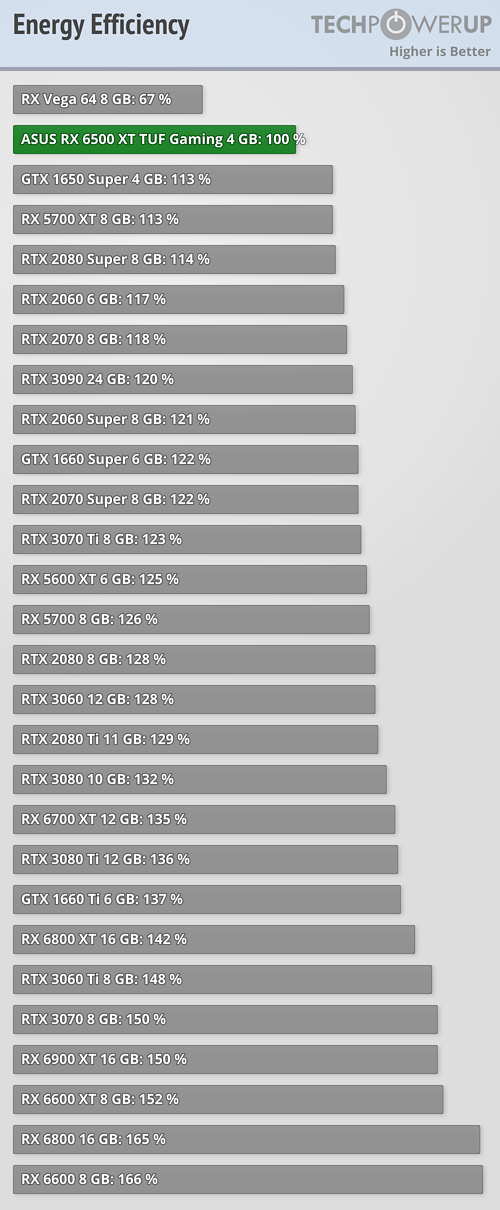 218
218
ASUS Radeon RX 6500 XT TUF Gaming Review - World's First 6 Nanometer GPU
Overclocking »Performance per Watt
Performance per watt is based on measurements using Cyberpunk 2077. We record power draw and FPS rate to calculate the energy efficiency of the graphics card as it operates.
Voltage Frequency Curve
The card will dynamically adjust clock and voltage based on render load, temperature, and other factors.For the graph below, we recorded all GPU clock and GPU voltage combinations of our 1440p resolution benchmarking suite. The plotted points are transparent, which allows them to add up to indicate more often used values. A light color means the clock/voltage combination is rarely used, and a dark color means it's active more often. The min/max values are 99th and 1st percentile, so outliers are excluded.

Clock States
| Clock Frequencies & Voltage | |||
|---|---|---|---|
| GPU Clock | Memory Clock | GPU Voltage | |
| Idle | 0 MHz 0 to 0 MHz | 3 MHz 2 to 8 MHz | 0.006 V 0.006 to 0.006 V |
| Multi-Monitor | 0 MHz 0 to 0 MHz | 2234 MHz 2234 to 2236 MHz | 0.006 V 0.006 to 0.006 V |
| Video Playback | 21 MHz 7 to 55 MHz | 2233 MHz 2220 to 2238 MHz | 0.711 V 0.706 to 0.718 V |
| Furmark | 2543 MHz 2533 to 2552 MHz | 2235 MHz 2234 to 2236 MHz | 0.992 V 0.987 to 1.018 V |
| Gaming (Cyberpunk 2077) | 2904 MHz 2902 to 2906 MHz | 2234 MHz 2234 to 2236 MHz | 1.200 V 1.200 to 1.200 V |
| V-Sync (Cyberpunk 2077) | 2904 MHz 2903 to 2906 MHz | 2234 MHz 2234 to 2236 MHz | 1.200 V 1.200 to 1.200 V |
| Gaming (23 Games) | 2906 MHz 2707 to 2914 MHz | 2234 MHz | 1.200 V 1.012 to 1.200 V |
Jul 12th, 2025 03:36 CDT
change timezone
Latest GPU Drivers
New Forum Posts
- What's your latest tech purchase? (24237)
- What are you playing? (23921)
- Can you guess Which game it is? (226)
- Gigabyte graphic cards - TIM gel SLIPPAGE problem (144)
- [Intel AX1xx/AX2xx/AX4xx/AX16xx/BE2xx/BE17xx] Intel Modded Wi-Fi Driver with Intel® Killer™ Features (367)
- NVIDIA RTX PRO 6000 Workstation Runs Much Hotter Than 5090 FE (22)
- 3D Printer Club (539)
- Will you buy a RTX 5090? (644)
- [GPU-Z Test Build] New Kernel Driver, Everyone: Please Test (89)
- No offense, here are some things that bother me about your understanding of fans. (34)
Popular Reviews
- Fractal Design Epoch RGB TG Review
- Corsair FRAME 5000D RS Review
- Lexar NM1090 Pro 4 TB Review
- NVIDIA GeForce RTX 5050 8 GB Review
- NZXT N9 X870E Review
- Sapphire Radeon RX 9060 XT Pulse OC 16 GB Review - An Excellent Choice
- AMD Ryzen 7 9800X3D Review - The Best Gaming Processor
- Our Visit to the Hunter Super Computer
- Upcoming Hardware Launches 2025 (Updated May 2025)
- Chieftec Iceberg 360 Review
TPU on YouTube
Controversial News Posts
- Intel's Core Ultra 7 265K and 265KF CPUs Dip Below $250 (288)
- Some Intel Nova Lake CPUs Rumored to Challenge AMD's 3D V-Cache in Desktop Gaming (140)
- AMD Radeon RX 9070 XT Gains 9% Performance at 1440p with Latest Driver, Beats RTX 5070 Ti (131)
- NVIDIA Launches GeForce RTX 5050 for Desktops and Laptops, Starts at $249 (119)
- NVIDIA GeForce RTX 5080 SUPER Could Feature 24 GB Memory, Increased Power Limits (115)
- Microsoft Partners with AMD for Next-gen Xbox Hardware (105)
- Intel "Nova Lake‑S" Series: Seven SKUs, Up to 52 Cores and 150 W TDP (100)
- NVIDIA DLSS Transformer Cuts VRAM Usage by 20% (97)